SEO is often a critical acquisition channel for startups.
Here, we’ll share actionable advice on how to get going with SEO for startups on a budget. Without expensive and complicated tactics.
Let’s start with how to get buy-in for SEO in the first place.
Justifying Investing in SEO for Startups
You need support from leadership to launch an SEO program that will help you achieve business goals.
If everyone is sold on SEO and ready to go, skip to the next section.
But if anyone on your team feels hesitant, you’ll need to overcome that.
Skepticism around SEO investment usually happens due to:
- A misunderstanding about what SEO involves
- Concerns that results will be too slow
Let’s go over how to address both:
Help Leadership Understand What SEO for a Startup Involves
Educating leadership about what implementing an SEO plan takes will keep them from thinking you’re talking about anything that could sacrifice the brand image. Like creating low-quality content or engaging in keyword stuffing (see an example from Google below).

So, be specific about what you’re proposing. Instead of saying “we’ll do SEO,” be clearer.
For example, say that you’ll:
- Hire two freelance writers
- Produce eight pieces of long-form blog content per month
- Create quality content that we’re proud to share
- Prioritize [category/use case] topics because they appeal to our most satisfied users
It also helps to position SEO as a distribution channel rather than saying you’ll create “SEO content.”
You can explain that you’ll create quality content that will be helpful for your ideal prospects (and current customers). And optimize it to rank highly in search engine results to drive traffic to it.
You might even mention that our State of Search report shows a clear correlation between high rankings and clicks through to those websites.
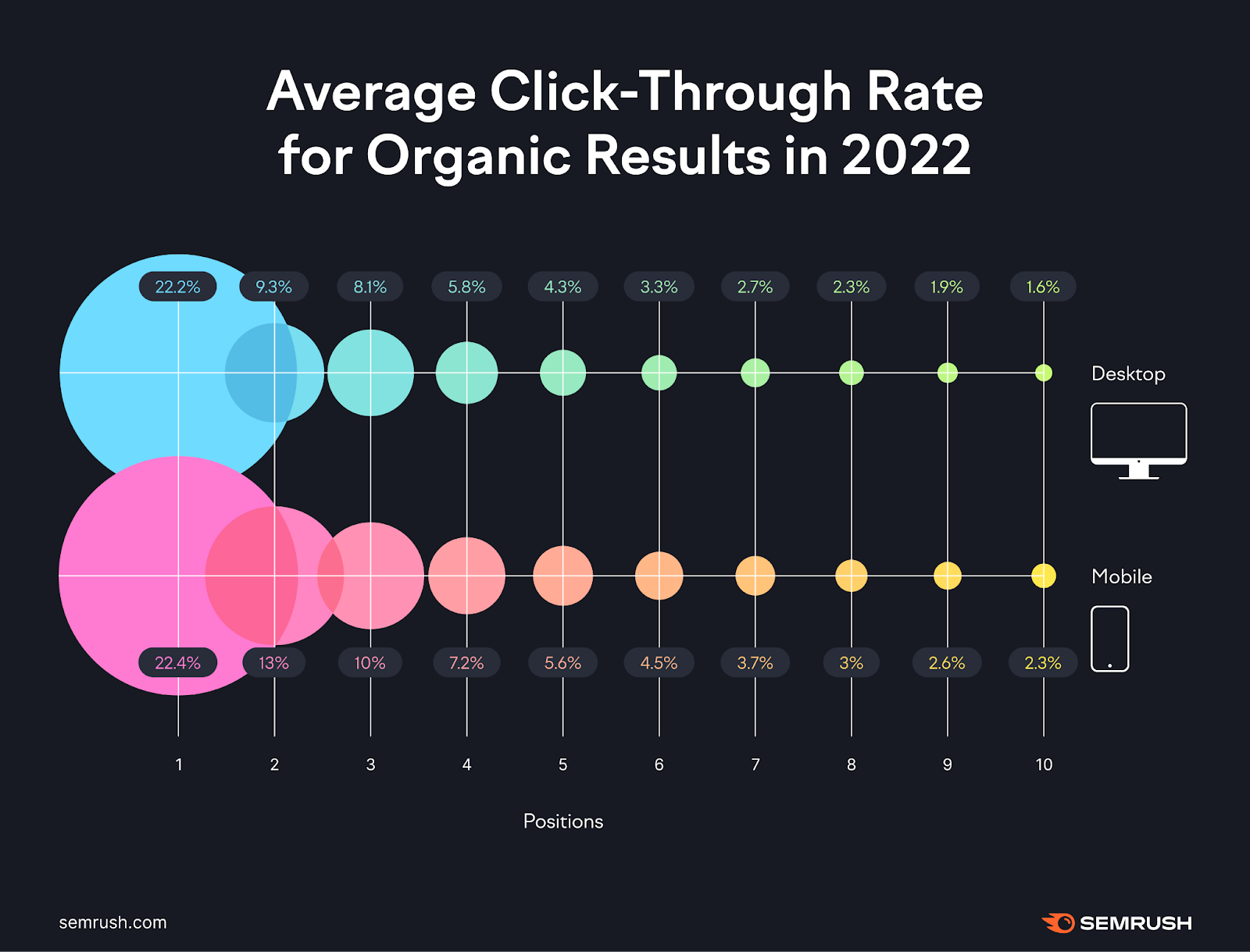
SEO Doesn’t Have to Take 6+ Months
Leveraging a sound SEO strategy for startups can help any new business with just one person creating content start to see SEO results within a few months.
You might not rank for category-defining keywords in that time. But you’ll get some small early wins with the right approach.
Let’s dive into what that involves:
5 Steps to Improve SEO for a Startup
1. Conduct Keyword Research
You’ll see SEO results faster if you prioritize keywords that indicate searchers need a solution you can provide.
If you’re doing SEO for software-as-a-service (SaaS) startups, for example, good topics might include things like:
- How to [use case]
- [Category] software/tools/platforms
- [Brand] alternatives
Imagine you’re a kanban board software. Applying those categories, we might find:
- How to track task statuses
- Kanban board software/task management tools
- Trello alternatives
These types of keywords clearly indicate that searchers need the solution that a kanban software provides, so it’s reasonable to expect high conversion rates.
(Higher than “task management methods,” for example. Which indicates the person is looking for information—not for a solution.)
Next, you need to consider monthly search volume and Keyword Difficulty (KD). KD is a score from 0 (easy) to 100 (hard) which reflects how difficult it is to rank in the top 10 for that keyword.
The earlier you are in your SEO journey, the less likely you are to succeed in ranking for keywords with high difficulty scores. To get some initial traction, you’ll want to focus on ones with less competition.
To get KD and volume data, you’ll need a keyword research tool like Keyword Magic Tool.
Open the tool, enter a seed idea (a broad term related to your product or service), and click “Search.” We’ll use “project management software” in this example.

You’ll then see a list with thousands of keywords.
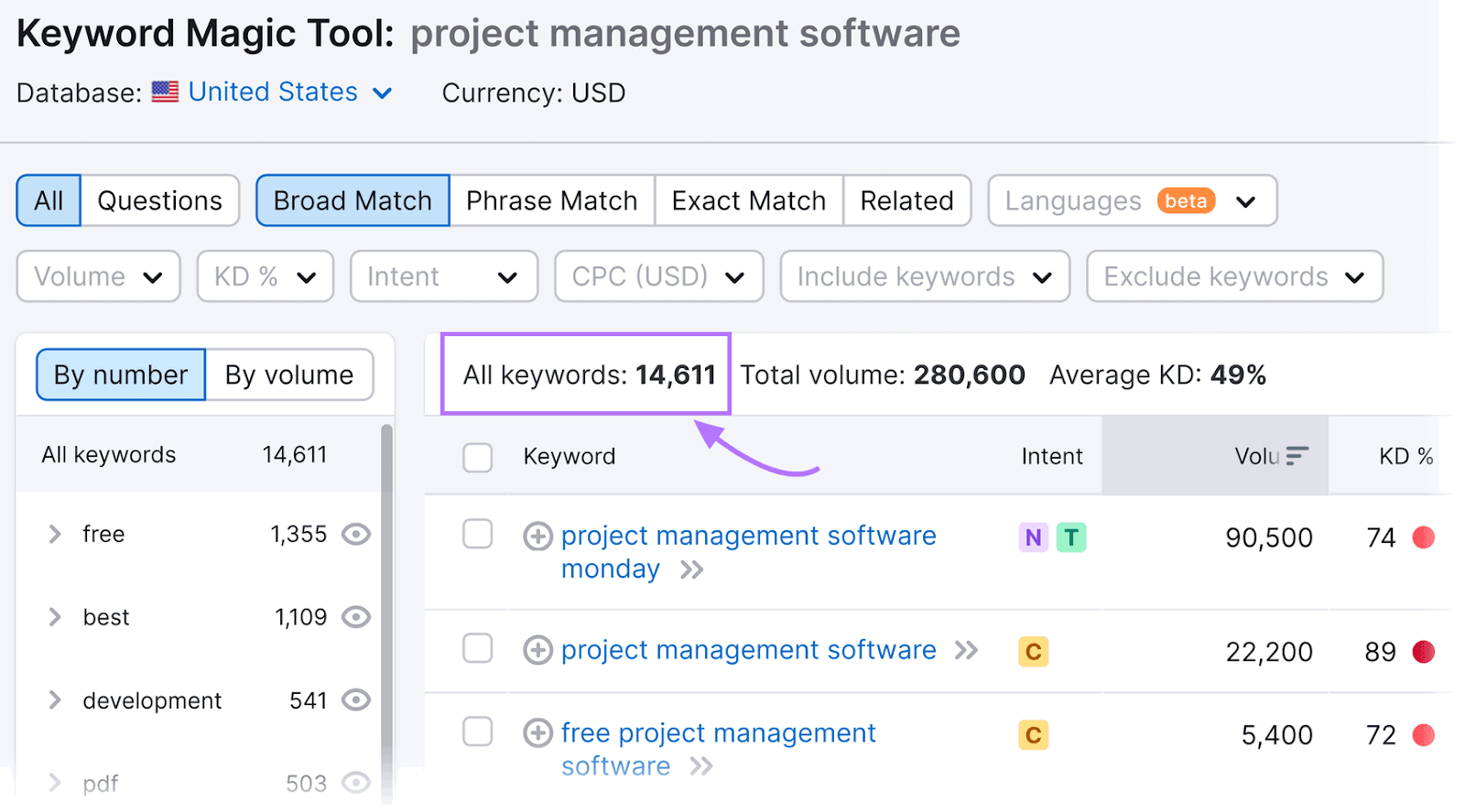
Next, we want to add filters. “Project management software” might have over 22K monthly searches, but with a KD of 89, it’s far too difficult to pursue as a startup.
Let’s look for easier variations by applying a “KD %” filter set from 0 to 29.
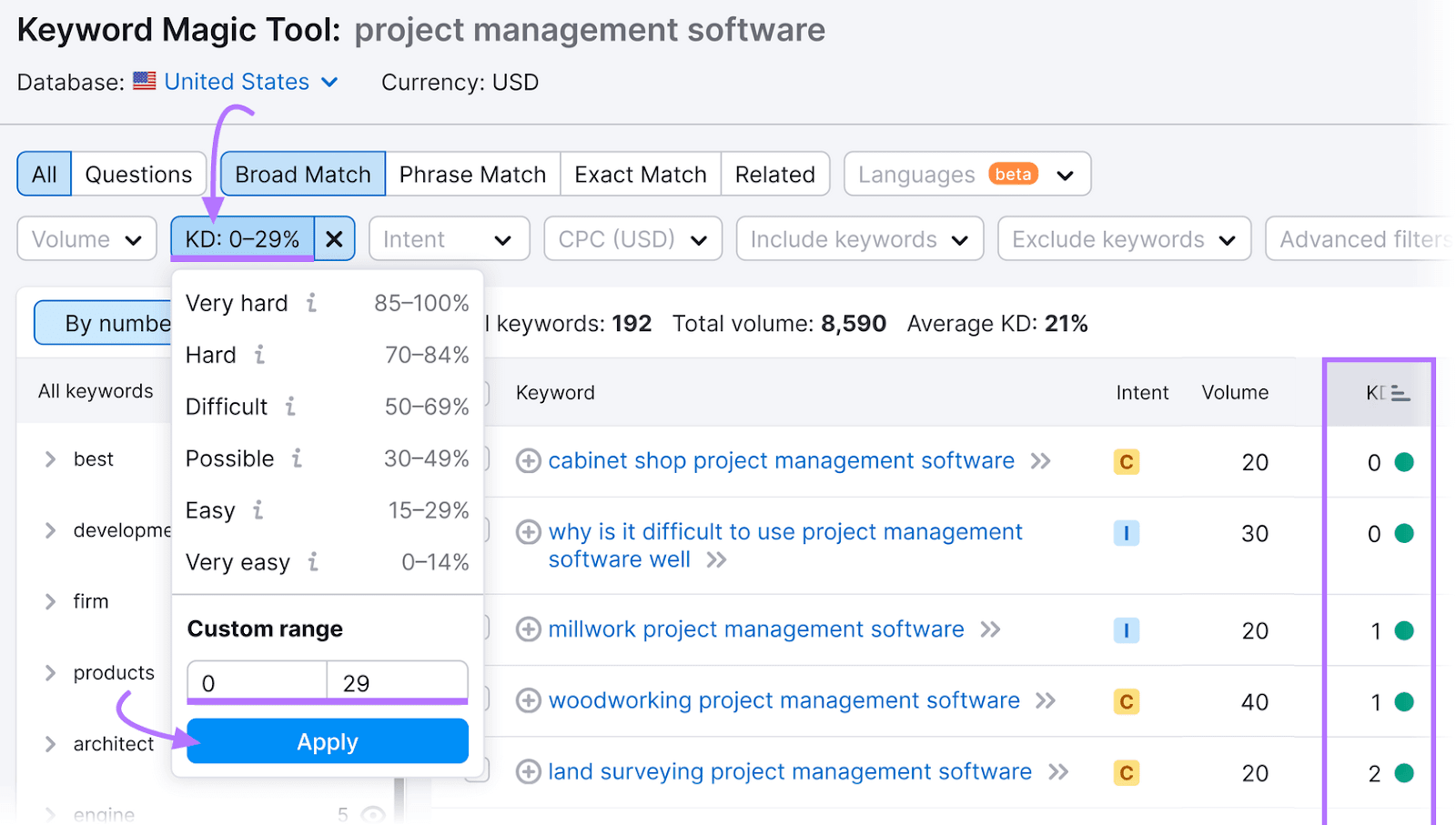
We now have variations like “land surveying project management software” which have a lower keyword difficulty. You’re much more likely to see some early results by focusing on more specific variations like these.
If you want to find the keywords which have both low difficulty and higher search volume, click on the “Volume” column to sort by highest volume within your criteria.
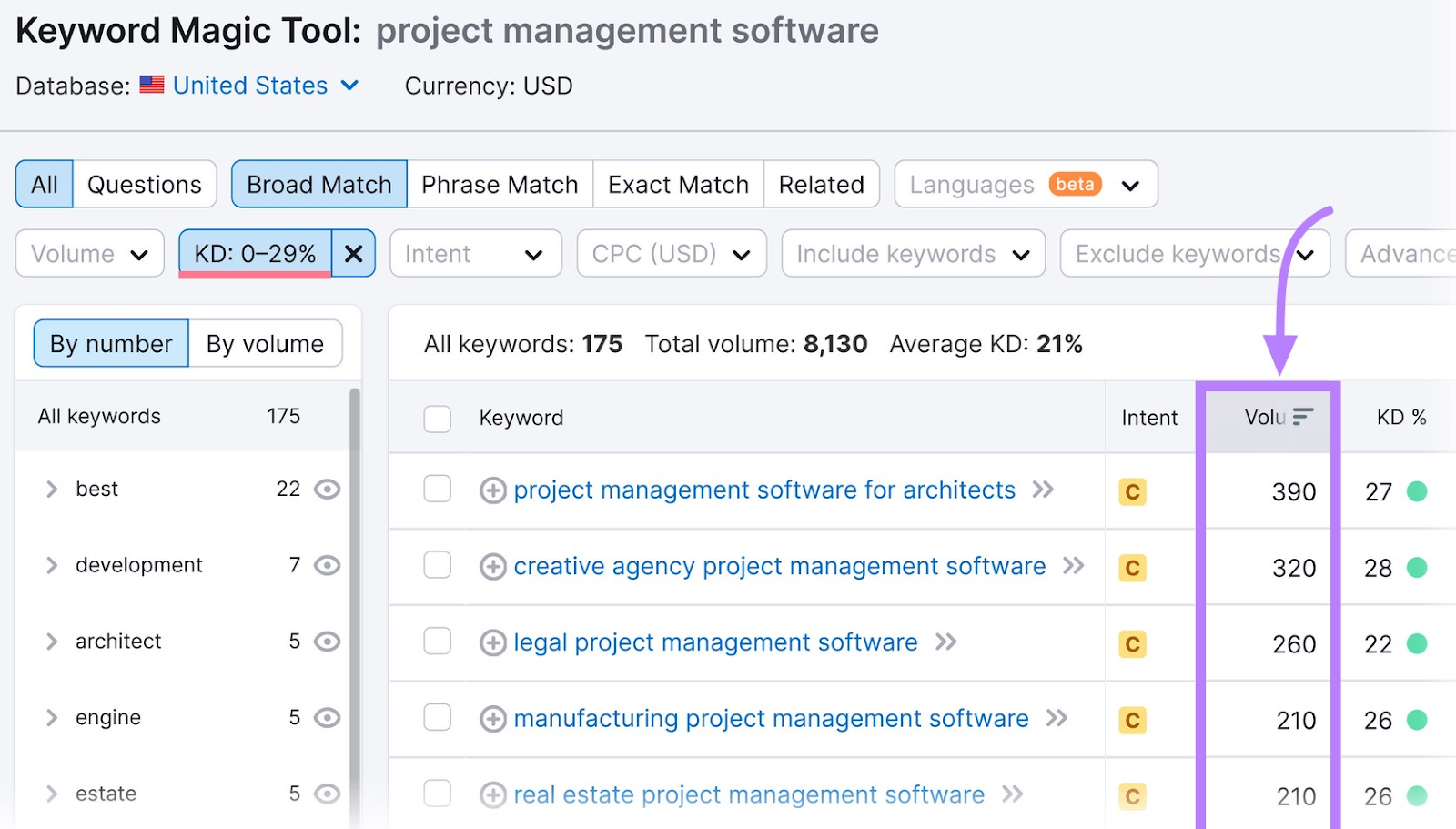
“Project management software for architects” and “legal project management software” have hundreds of searches per month on average, yet still have a lower keyword difficulty.
You can also find good keyword variations that are more specific (and typically have low difficulty scores) by using the suggested groups and subgroups in the column to the left of the keyword list.
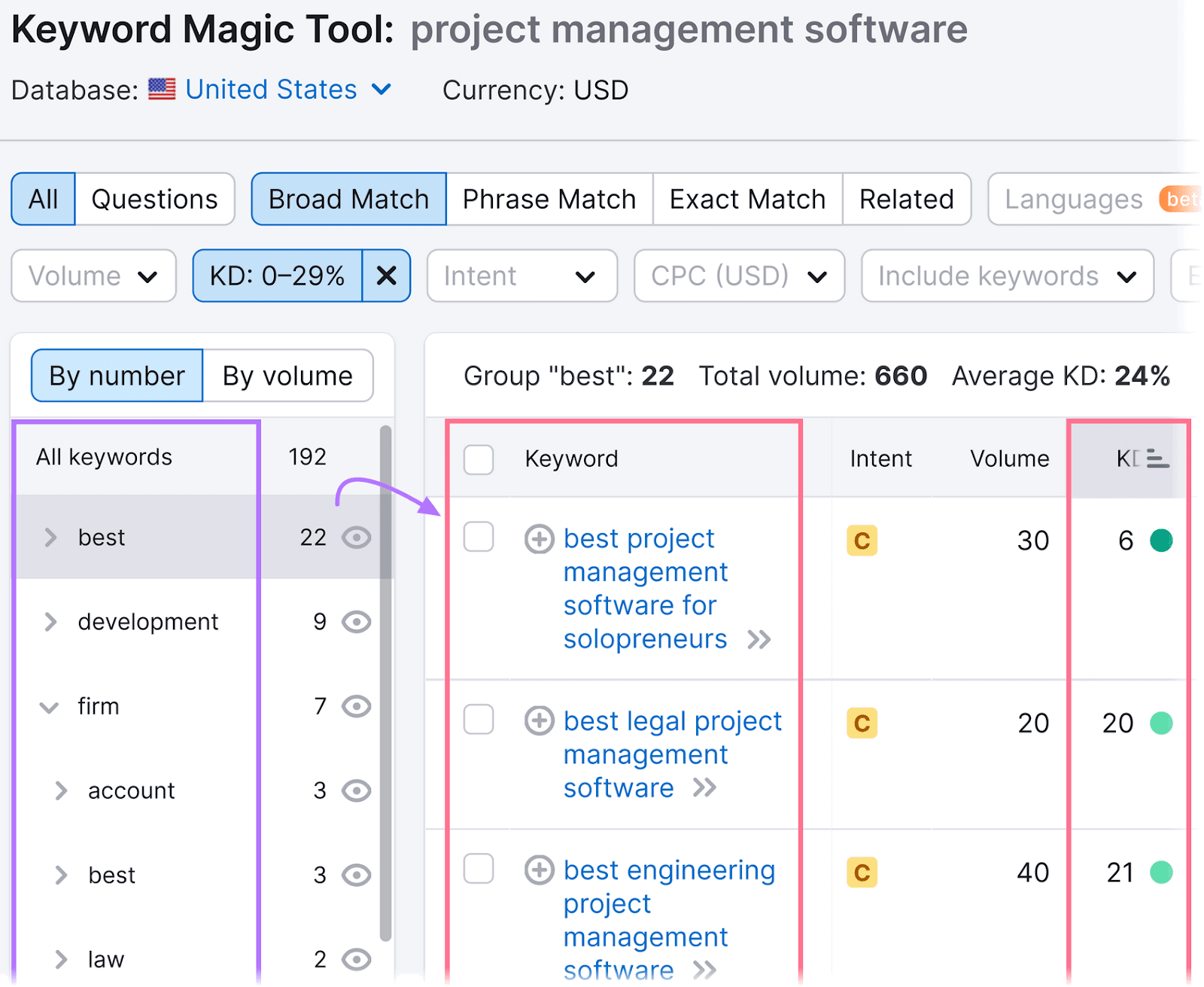
Repeat this process with a handful of seed ideas. And it will form the basis of your initial SEO content plan.
To get more ideas, you can:
- Talk to customers: If you can’t ask directly, get close to customer-facing teams like sales, customer success, and support. And ask them to share the challenges they’re hearing about.
- Analyze your competitors: Tools like Organic Research let you check which keywords drive their traffic. Just enter a competitor’s domain and then navigate to the “Positions” tab to see information about their top keywords.
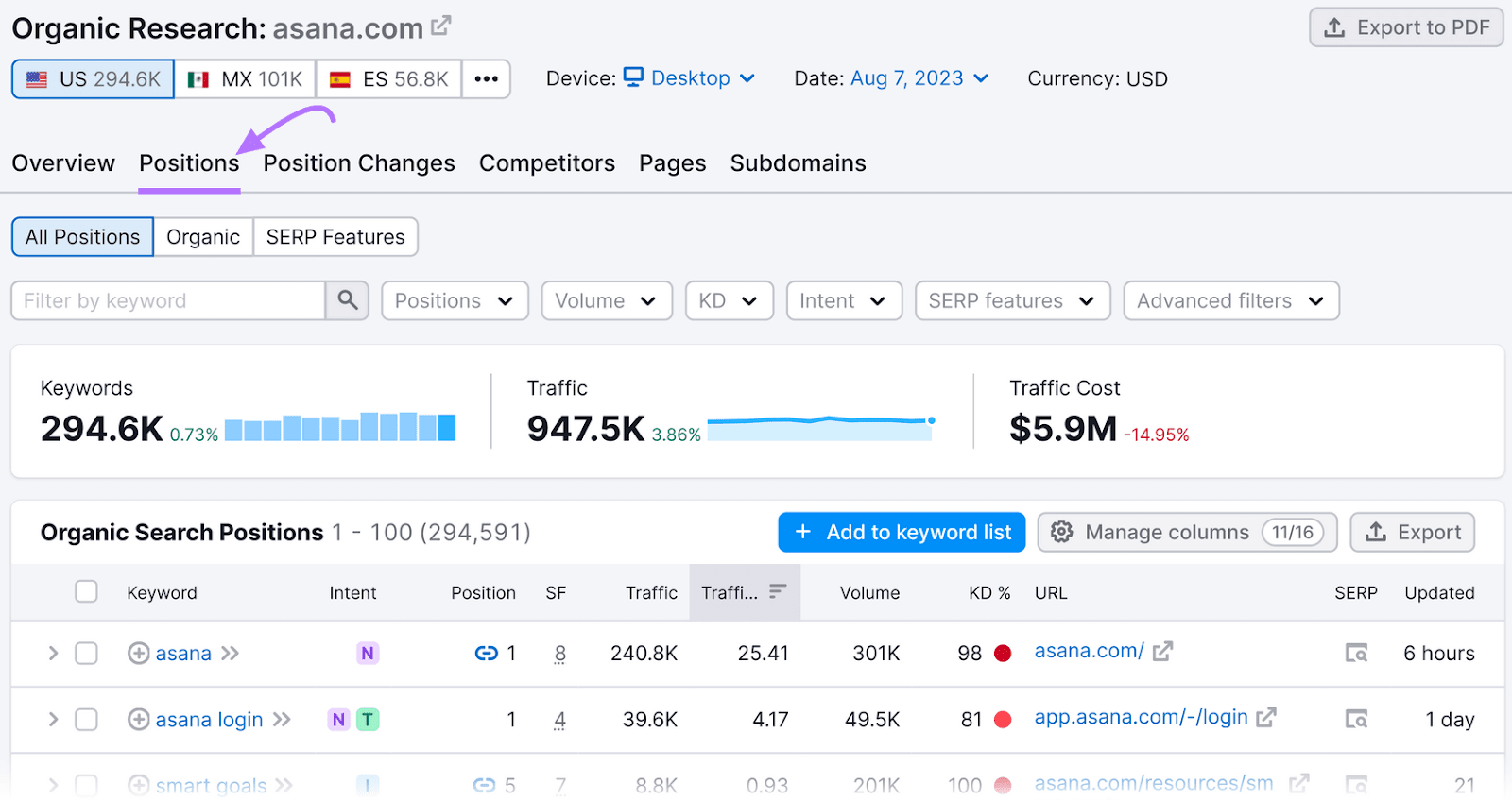
Further reading: How to Do Keyword Research for SEO.
2. Start Creating Content
Next, focus on creating content targeting the keywords you discovered during research. Because the sooner you start getting content produced and published, the sooner you can potentially start ranking.
Here’s a simple process to get started creating SEO-friendly content:
Determine Who Will Write the Content
If you have in-house content resources, great. If not, you’ll need to hire.
Your options are:
- Full-time, in-house writers
- Freelance writers
- An agency that has content writers
Often, startups get SEO content creation off the ground using freelancers.
Here are the advantages to going that route:
- You don’t have long-term commitments like with an in-house hire
- You can start with a smaller budget
- You’ll benefit from working with someone who probably has writing/editing knowledge from working with other clients
The main downside to consider is that freelancers typically won’t understand your product as well as an in-house hire will.
Create an SEO Brief Template
SEO content briefs are key to scaling content. Because they help writers understand exactly how to execute each piece and reduce back-and-forth and editing time.
Creating a standardized template for your briefs will speed up the process.
Briefs can vary in their comprehensiveness, but they should all specify:
- Target keywords (both primary and secondary terms)
- An approximate word count—which you can provide a range for based on what you see in the search engine results page (SERP)
- A suggested structure that touches on all the main points the piece should cover
- Supporting resources like relevant research or other content you’ve created
It’s also a good idea to provide an explanation of what the search intent is.
Because if you don’t get it right, you won’t be able to rank.
With our “project management software” example, the SERP shows us that every top result is a list of different software solutions.

That’s the type of content you need to produce to compete. Anything else, like a product landing page, probably wouldn’t rank.
Simply check the current SERP in advance. And tell the writer how to satisfy the searcher’s intent.
You can mention:
- What format is needed (listicle, templates, “how to,” etc.)
- How knowledgeable the audience is (beginner, intermediate, or advanced)
- The level of detail they should provide
And for topics with high purchase intent, help the writer understand how your product solves searchers’ problems. Because there’s usually a natural opportunity to mention your solution.
Give the writer examples of how you’ve naturally mentioned your product or service in that type of content before. Like this example from Slack:
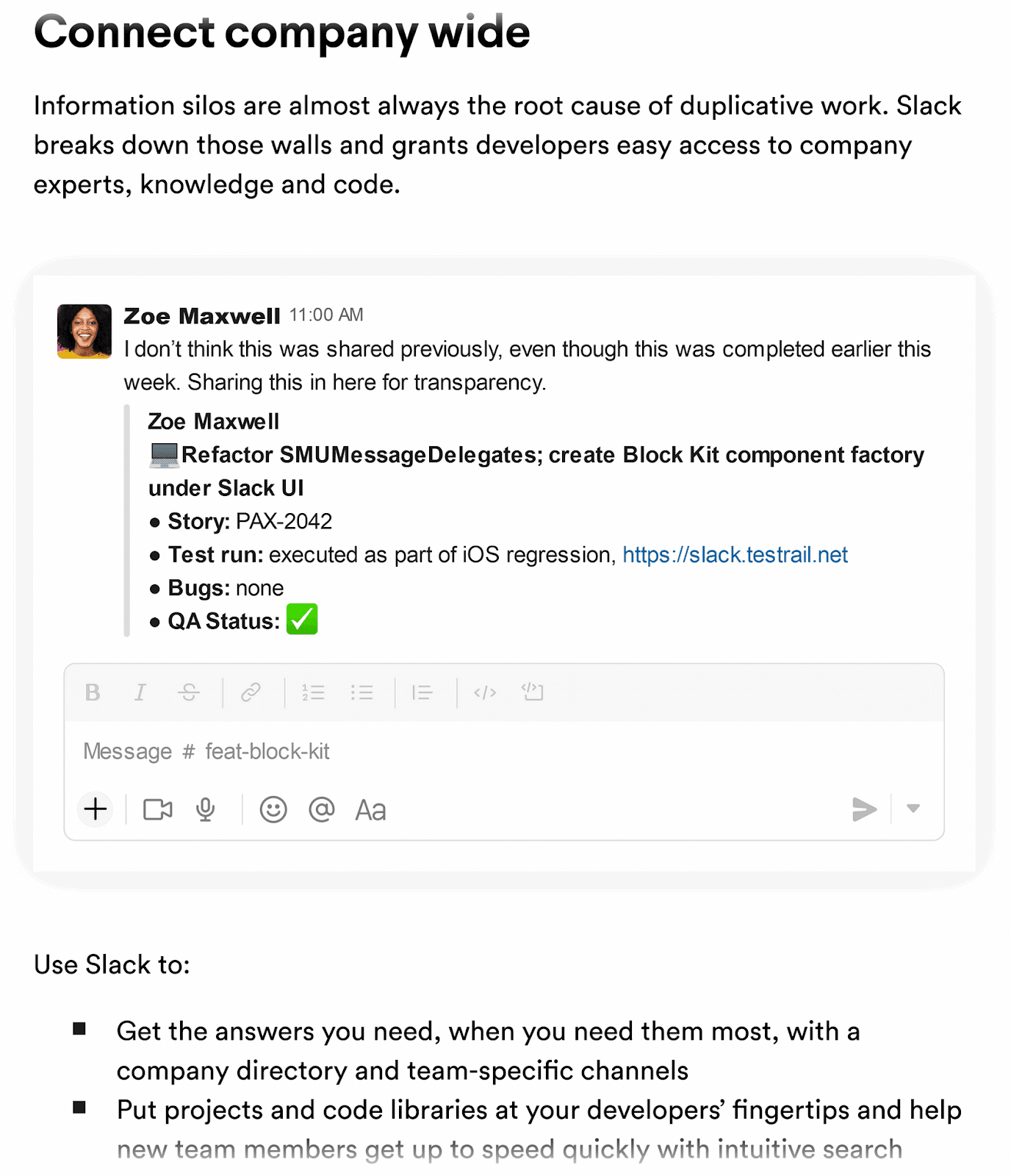
To see more real-world examples of how to pitch a product within content, just scroll up or down. There are lots of natural mentions of how Semrush helps startups with SEO throughout this page.
Further reading: How to Create the Perfect Content Brief.
Create an On-Page Optimizations Checklist
On-page optimizations are things you can do directly on your pages to maximize the chances of ranking for your target keywords.
Here’s a simple checklist you can use:
- Include the target keyword in your URL, title tag, meta description, H1, and subheadings as appropriate
- Use a simple, short, and clear URL so users can tell what the page is about
- Make sure proper header tags are used (H1, H2, H3, etc.)
- Add internal links to other related content
- Use appropriate images, and optimize them by using a sensible file name, compressing the file size, and adding alt text
You can do these things yourself before publishing. Or add it to the content brief as part of the writer’s scope of work.
Further reading: On-Page SEO: What It Is and How to Do It
Document Your Style and Editing Preferences
Style guidelines will help you onboard new writers faster, save on editing time, and increase the quality of your output.
You don’t necessarily need one to get started. But start taking note of your editorial preferences and brand particulars that will come together to form style guidelines over time.
Think about things like:
- American English vs. British English
- Sentence case vs. title case capitalization
- Preferred tone
- Examples of great intros
You can also leverage an existing style guide like the AP Stylebook to guide you.
3. Follow Some Technical SEO Basics
For most startups, technical SEO foundations like ensuring an SEO-friendly architecture, creating an XML sitemap, and applying some basic load speed improvements are enough at first.
Generally, you’ll get more bang for your buck by creating more content in the early stages.
But the three tactics we mentioned above are worth your attention:
Create an SEO-Friendly Site Architecture
The fewer clicks it takes to get from the homepage to other key pages, the better. Because it makes it easier for users and search engines to find their way around your site.
You should aim for a relatively flat site structure. And avoid having any pages which are inaccessible due to having no internal links pointing to them (known as orphaned pages).
Like this:
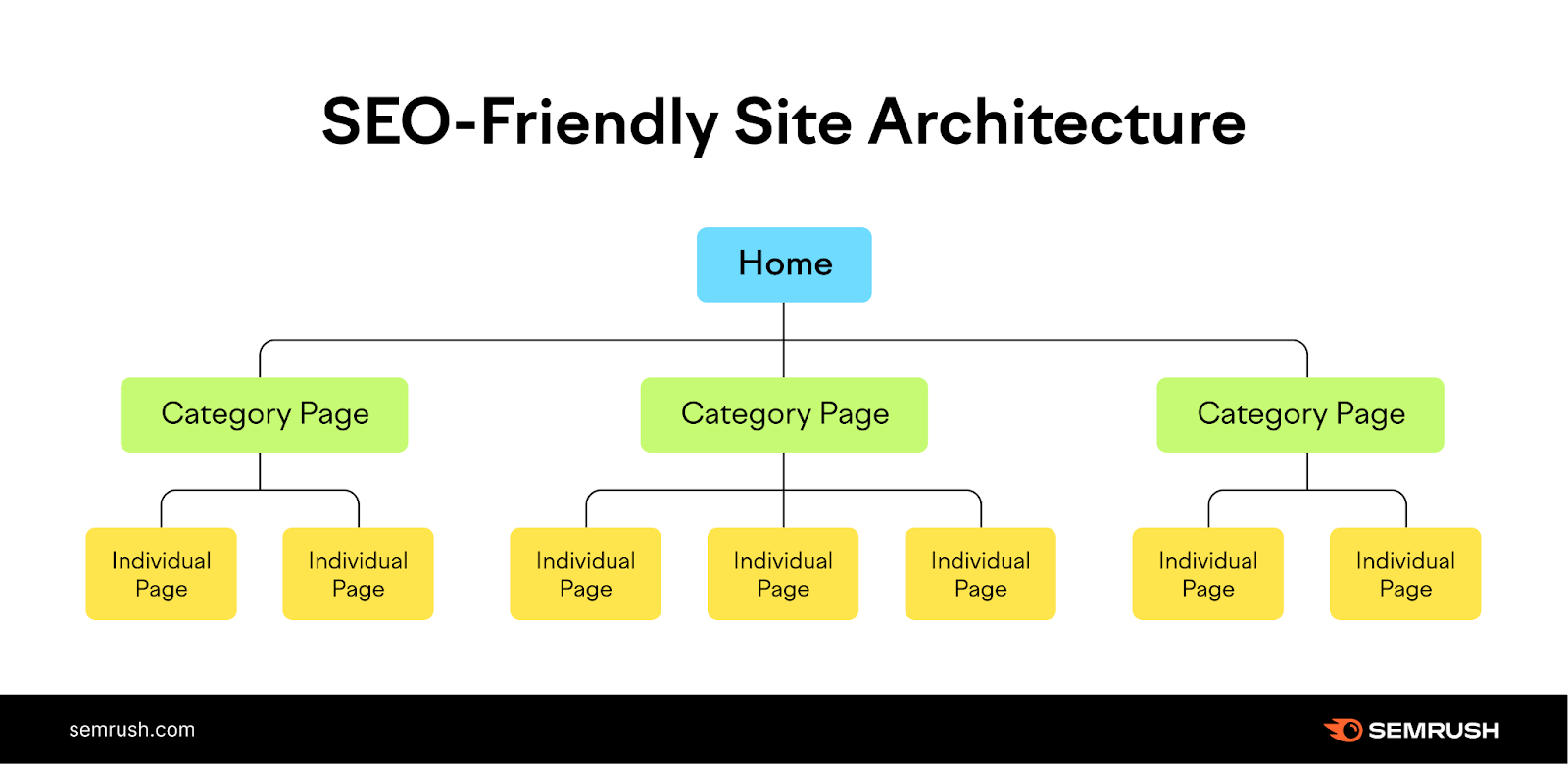
Implementing a logical, user-friendly structure early on is better than doing it later.
Why?
Because the longer you leave it in subpar condition, the more difficult it will be to change.
As you plan your structure, think about:
- Using navigation and footer links to access key subfolders (e.g., /blog/ or /category/)
- Internally linking related pages together
- Minimizing click depth (how many clicks it takes to get to a page from the homepage)
- Avoiding orphaned pages
Site Audit can help you find orphaned pages.
When you create your first project, you’ll have a few settings to configure.
In most cases, the default settings work fine—but you may want to increase the limit of checked pages for larger sites.
Once you’re happy with the settings, click “Start Site Audit.”
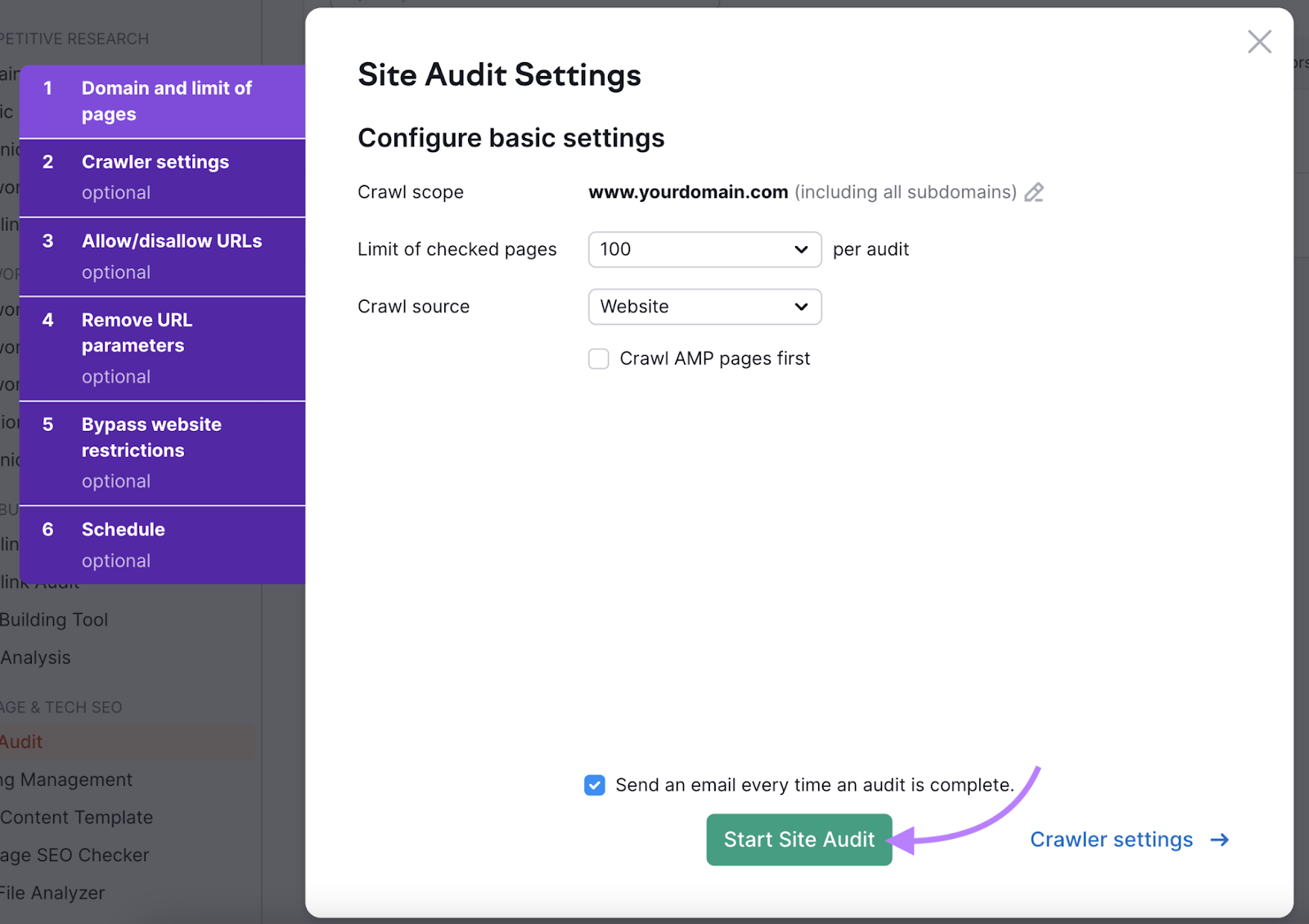
When it’s ready, go to the “Issues” tab.
There, you’ll see a search box. Enter “orphan” to find orphaned pages quickly.
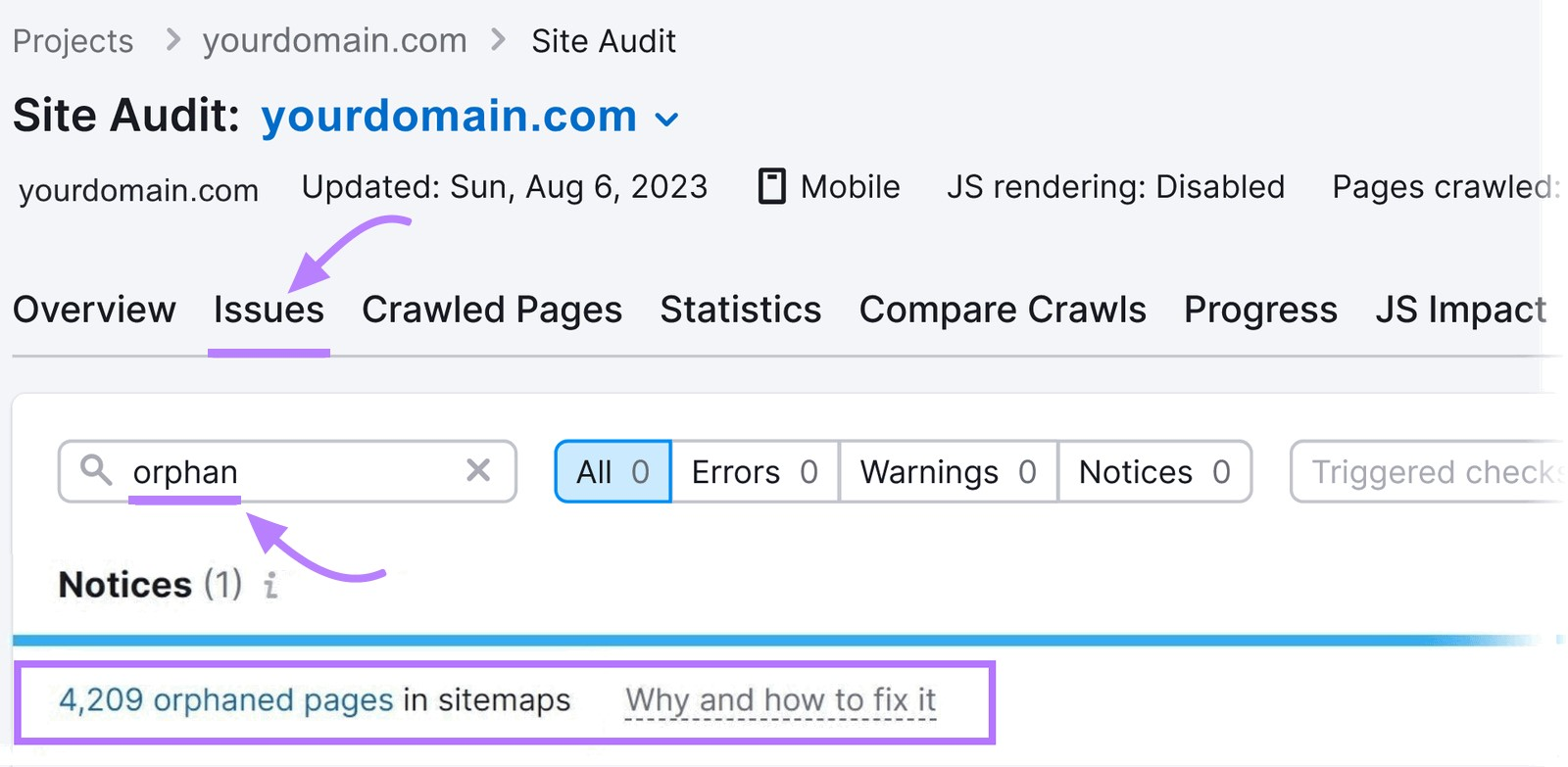
Find natural places on other pages to add internal links pointing to each of the orphaned pages. And you’re good to go.
Create and Submit an XML Sitemap
An XML sitemap can help search engines find your pages faster. And creating one is quick and doesn’t require recurring work.
Here’s an example of what they look like:
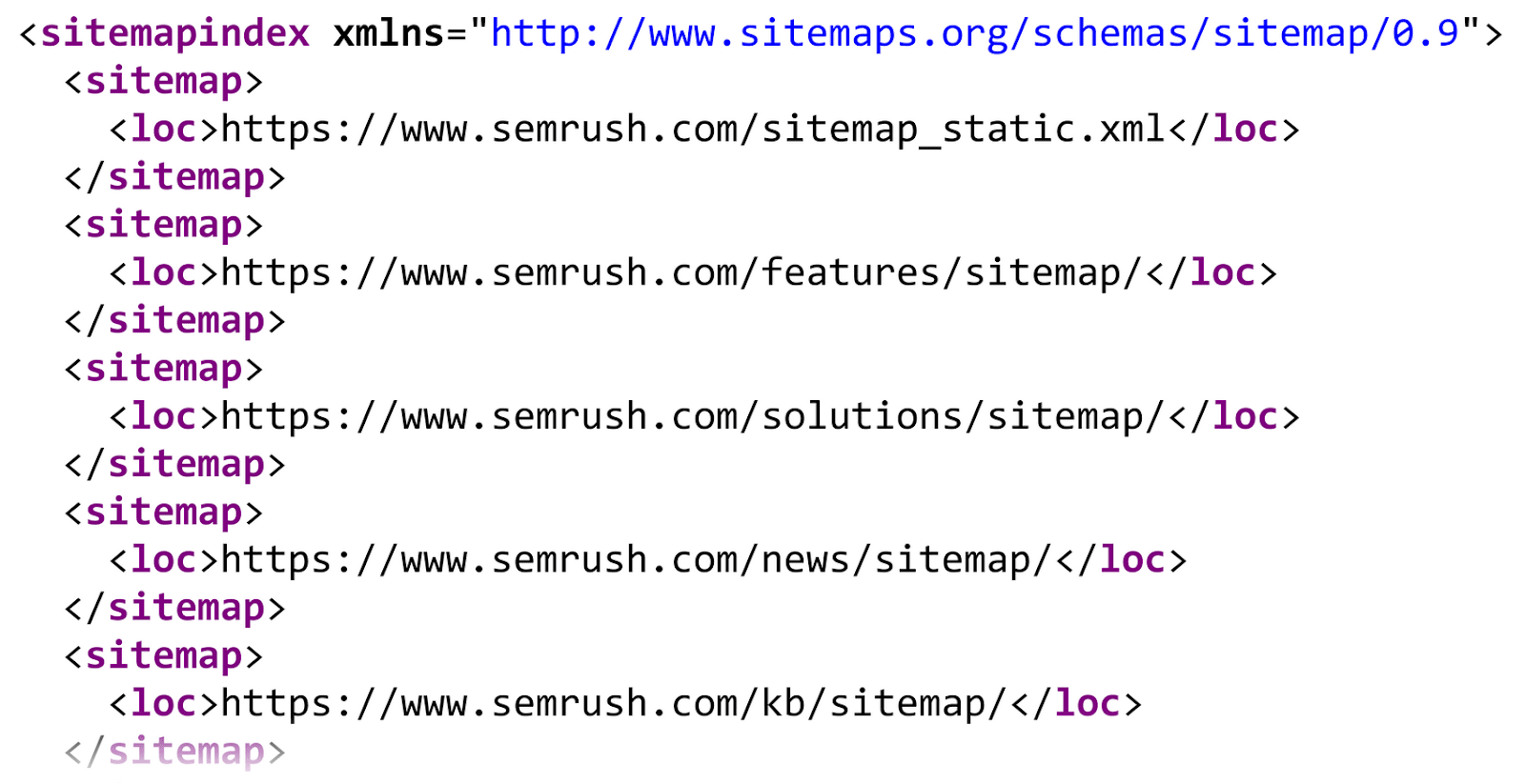
If you’re using a content management system (CMS), it will likely auto-generate a sitemap for you. This is true for WordPress, Shopify, Wix, and Squarespace.
If you don’t have a CMS, you can use a sitemap generator tool.
Once it’s created, submit the URL to Google Search Console. It’s usually something like yourdomain.com/sitemap.xml.
Improve Page Load Speed
Load speed is important because slow sites make for a poor user experience.
Page speed is also a confirmed ranking factor. All other things being equal, a fast-loading page is likely to perform better than a slow-loading page in Google Search.
The best way to get started is to run your key site pages through Google’s PageSpeed Insights tool.

You’ll get a ton of information about how well your page is performing, broken down into four scores: Performance, Accessibility, Best Practices, and SEO.
The Performance score is the one that matters for load speed.
Don’t shoot for a score of 100. Usually, that requires excessive optimizations to the point where you start to sacrifice other things (e.g., design).
Look for quick wins like:
- Removing unnecessary scripts: Get rid of any unused plugins and reduce the size of your CSS and JavaScript code
- Optimizing images: Compress slow-loading elements like large images and see whether you can implement a long-term solution (e.g., a plugin that automatically compresses upon upload)
- Enable browser caching: Install a plugin like W3 Total Cache if you use WordPress. Otherwise, research caching solutions for the CMS you use. Because browser caching lets users’ browsers memorize parts of your site to help it load quicker next time.
Further reading: How to Improve Your Google PageSpeed Insights Score
4. Do Strategic Link Building
In the beginning, you should prioritize content creation over gaining links from other sites.
If you’re tight on capacity and budget, you’ll likely be torn between the two. But start with carefully selected topics and focus on nailing the content first.
Then, it makes sense to begin link building.
Here are two startup-friendly link building tactics to consider:
Writing Guest Articles
Writing for another site is a tried and tested way to get backlinks.
Look for websites that:
- Are closely related to your niche but not in competition with you
- Are authoritative in your niche
- Publish quality content
Avoid generic news sites, sites that aren’t relevant, or sites that have potentially spammy backlinks or content.
Editors get bombarded with outreach for guest article opportunities. So, put some time and effort into your outreach to stand out.
Try to put yourself in their shoes. And pitch a topic that could drive some organic traffic and provide internal linking opportunities for their site.
Further reading: How to Guest Post For SEO.
Create Linkable Assets
A linkable asset is a type of content that earns backlinks naturally. Which means you can do less outreach.
Often, linkable assets include original research and statistics, free tools, and useful guides.
Here are a few great examples of linkable assets:
- Statistics and research: Semrush’s Content Marketing Statistics
- Free tool: Modash’s Fake Follower Checker
- Ultimate guide: HubSpot’s Guide to Video Marketing
To get some ideas, check competitors’ domains for linkable assets using Backlink Analytics.
Enter a competitor’s domain and click “Analyze.”

Go to the “Indexed Pages” tab to see which pages have attracted the most backlinks.
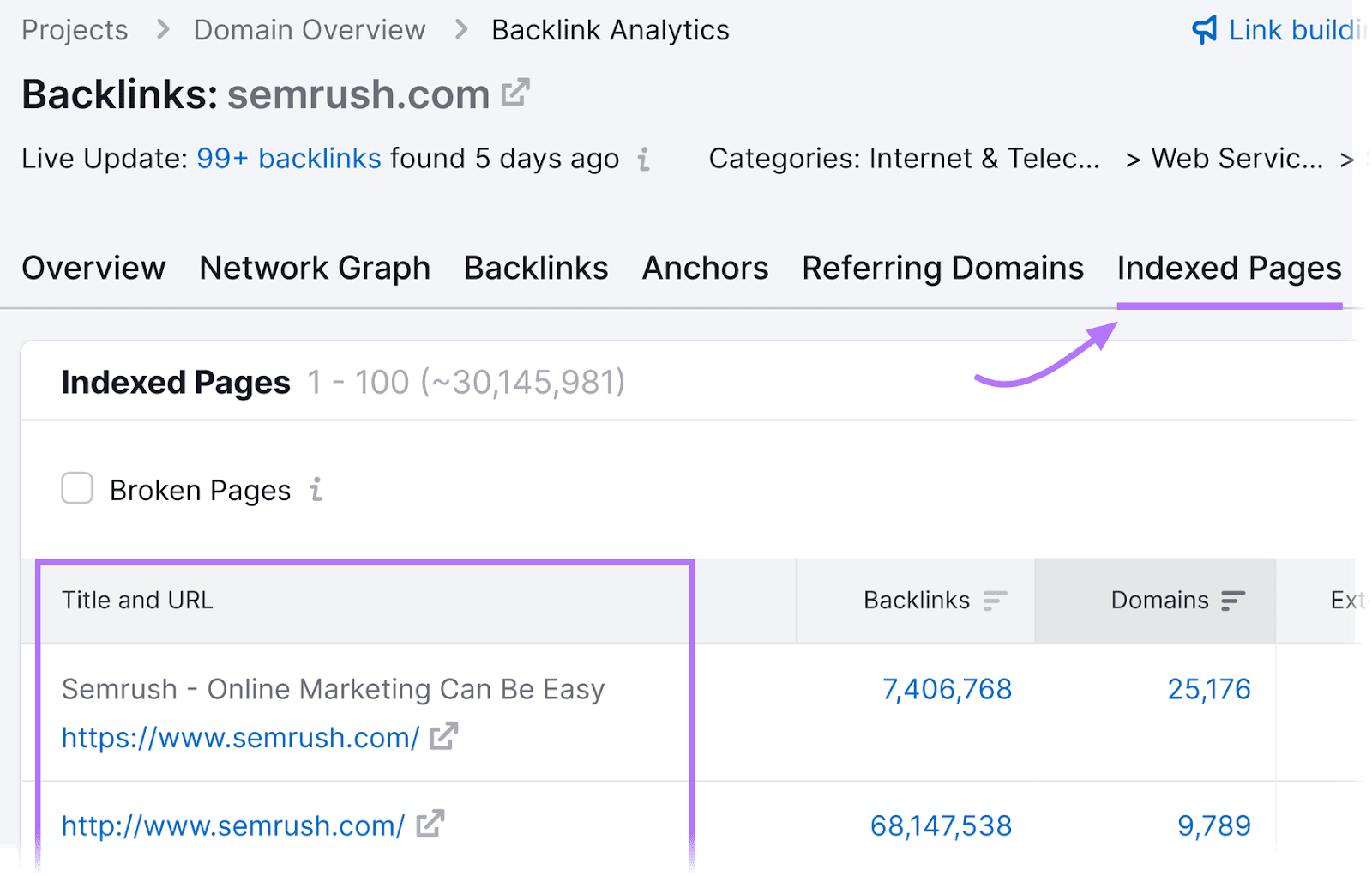
Doing this with a few different competitors will give you an idea of the types of content that earn links in your space.
5. Measure Your SEO Performance
You’ll need to measure SEO performance to see whether your SEO work is contributing to business goals. And to optimize your strategy as you go.
The exact metrics you’ll want to track will depend on what your overarching goals are.
But here are three metrics startups commonly track:
- Keyword rankings
- Organic traffic
- Conversions from organic traffic
Keyword Rankings
Rankings are a useful leading indicator. Because you’ll likely see progress there before the traffic and conversions start showing up.
A rank tracker is among the most useful SEO tools for startups. And can give you useful data about how your rankings are trending.
You can use Position Tracking to keep an eye on your rankings.
Open the tool, follow the configuration instructions, and then click “Set up tracking.”
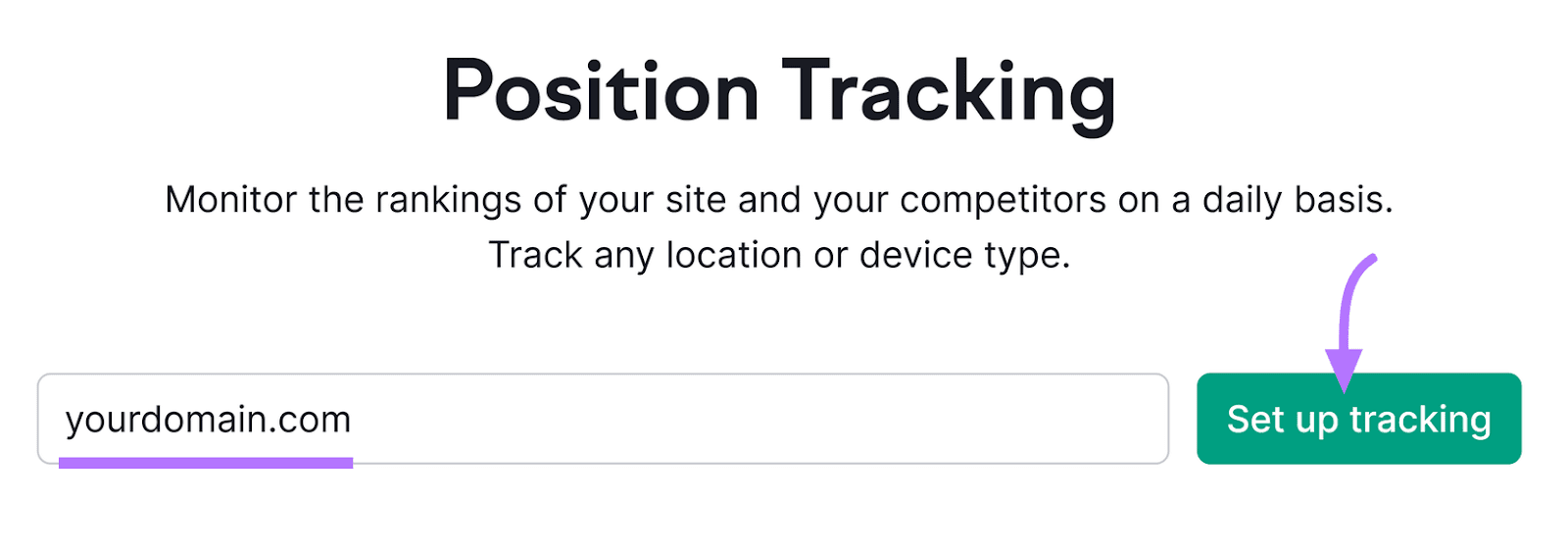
Head to the “Overview” report to see your list of keywords and how your rankings have changed (the default view shows changes over the last seven days).
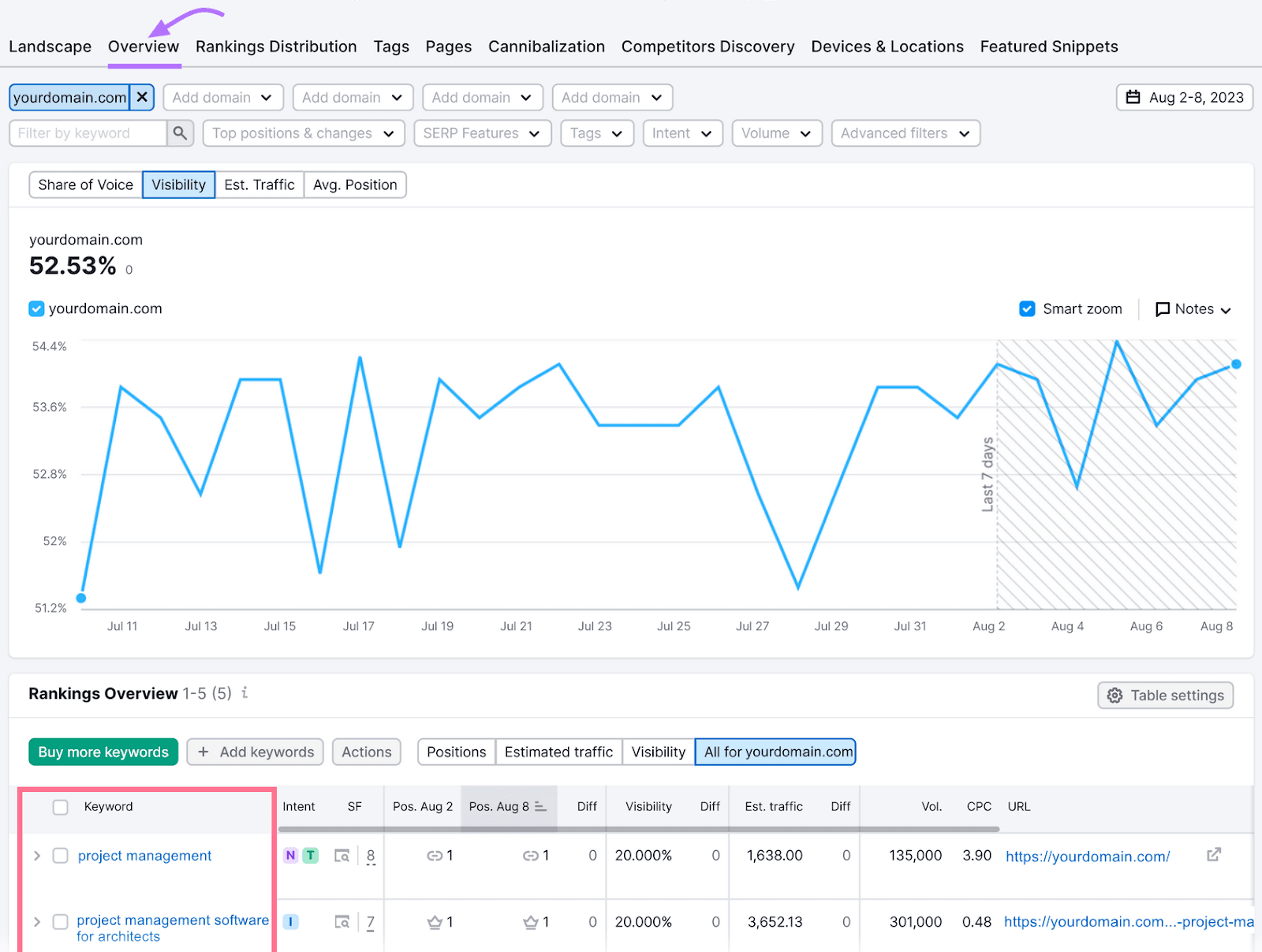
Organic Traffic
Organic traffic is the unpaid search traffic you’re earning through SEO efforts. And you need to track it because it’s a prerequisite for conversions (and revenue) from SEO.
And organic traffic can be tracked for your entire domain, for specific pages, and for subfolders.
For example, you can track organic traffic to your blog specifically by only looking into URLs that are unique to your blog content (for most sites, that means URLs that look something like yourdomain.com/blog/).
The easiest way to segment your traffic by subfolder like that is with Google Search Console (GSC). If you haven’t used it before, you’ll need to verify ownership of your website. Learn how to do that in our GSC guide.
Click “Performance” in the left sidebar (or “Full report”).
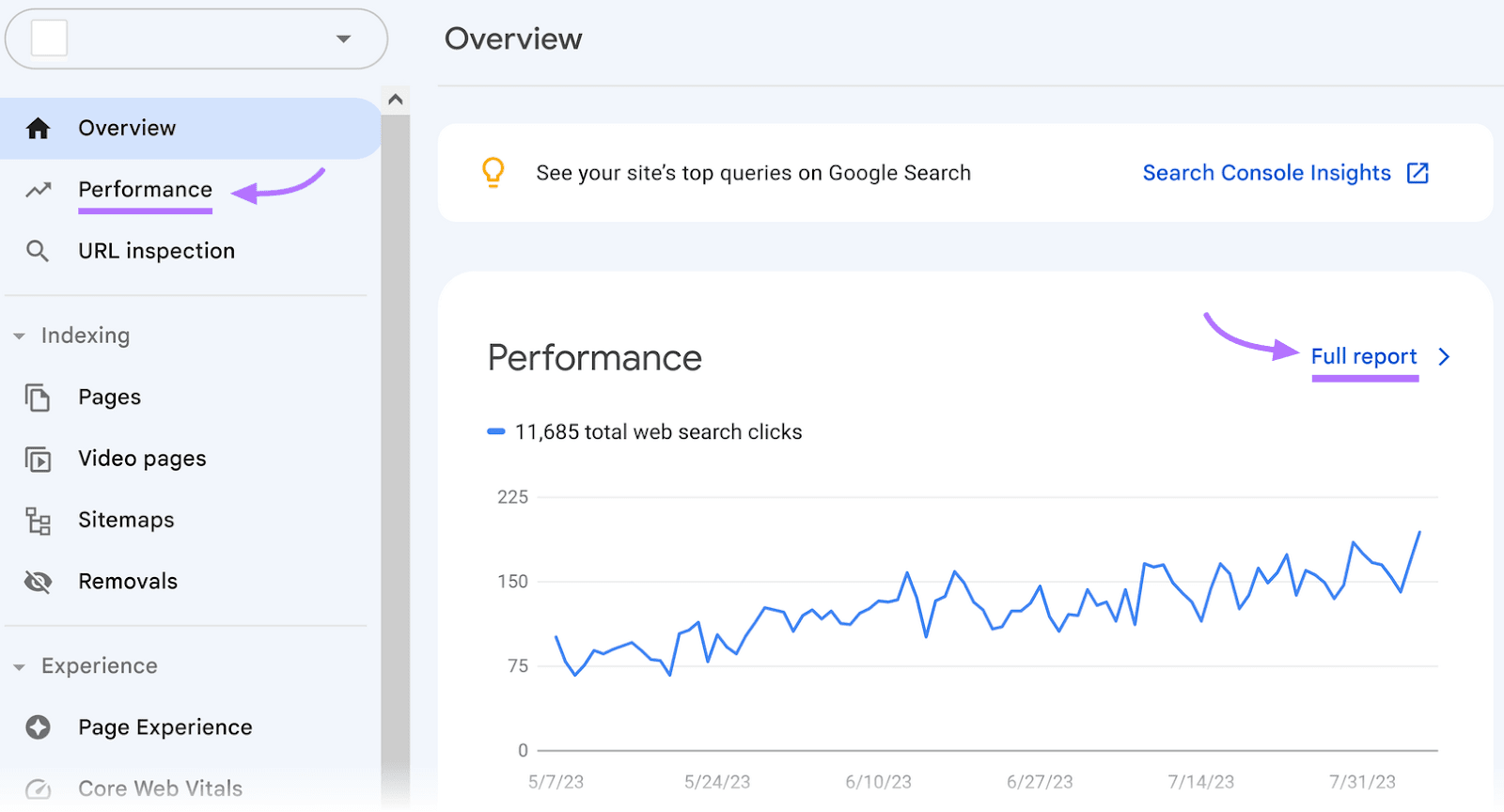
Next, click on “+ New,” and select “Page.”
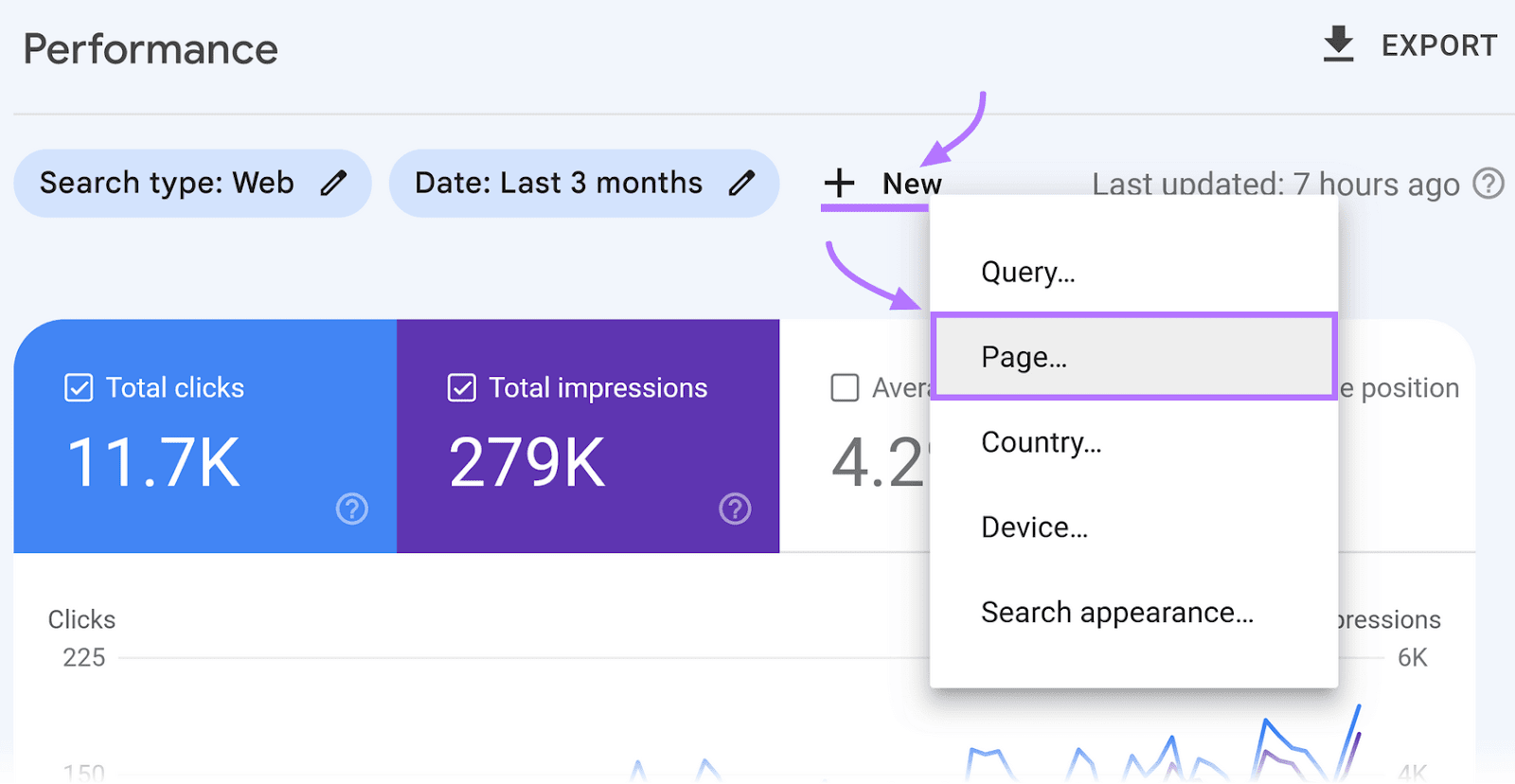
Lastly, use “URLs containing” and enter whichever characters would identify the subfolder you want to measure (e.g. “/blog/”).
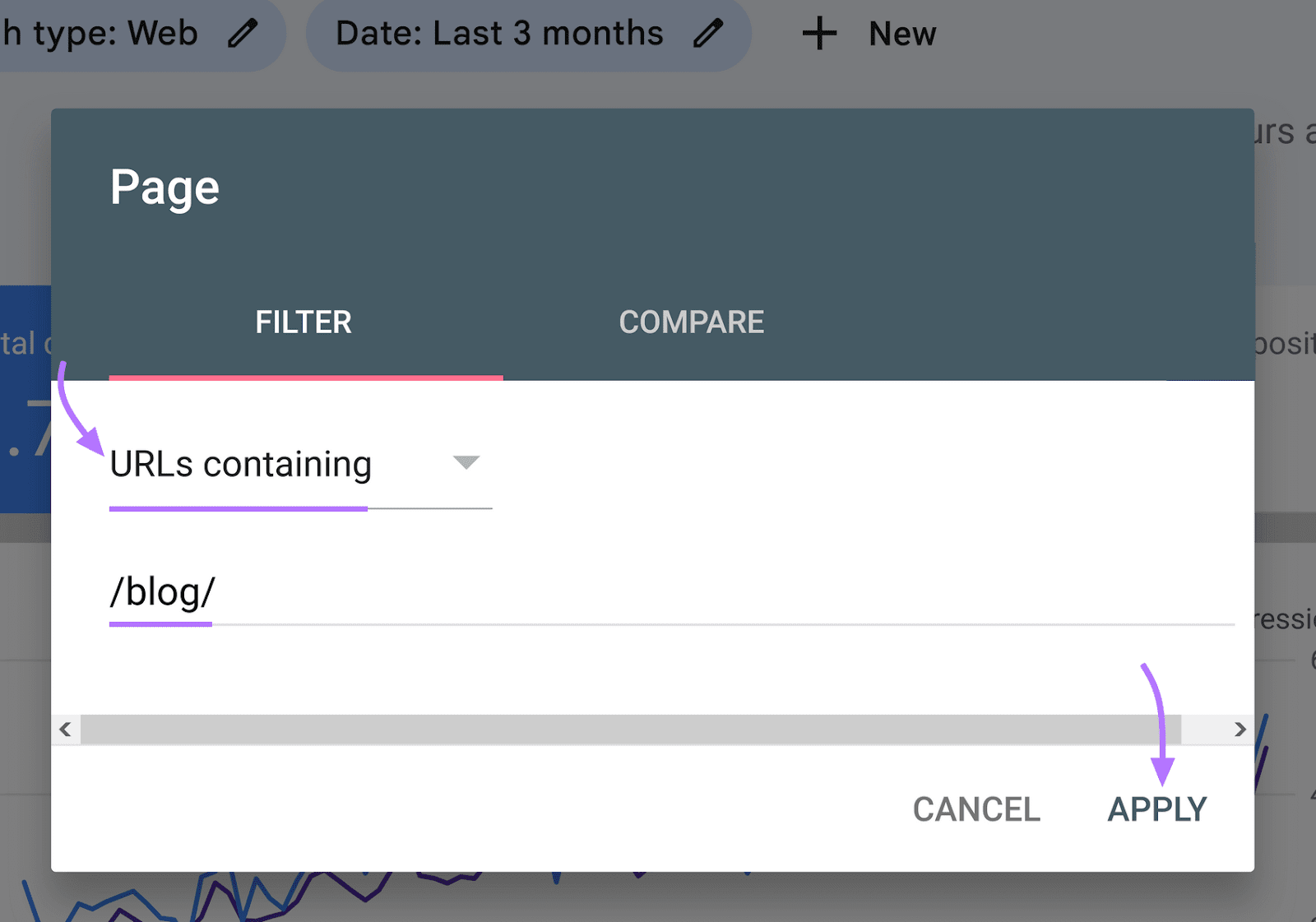
Doing this helps you visualize the impact of your work better than looking at overall organic traffic to your website.
Conversions from Organic Traffic
All the traffic you earn is only worthwhile if it translates into valuable actions (e.g., purchases, signups, downloads).
To track your conversions from organic traffic in Google Analytics 4, you first need to set up events.
Once that’s taken care of, go to “Life cycle” > “Acquisition” > “Traffic acquisition.”
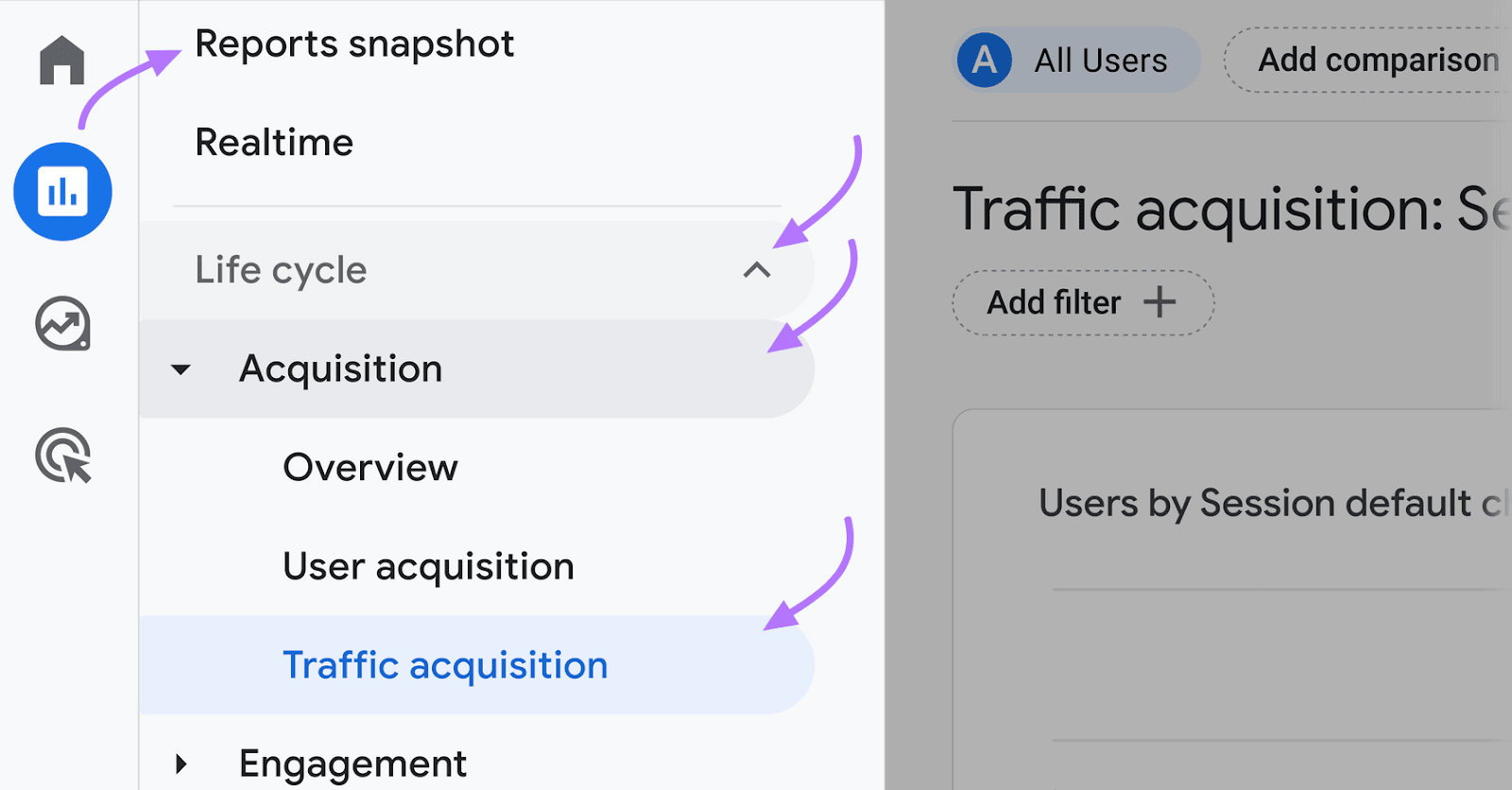
Scroll down to the table. And look at the “Organic Search” row to see how unpaid search traffic is contributing to conversions.
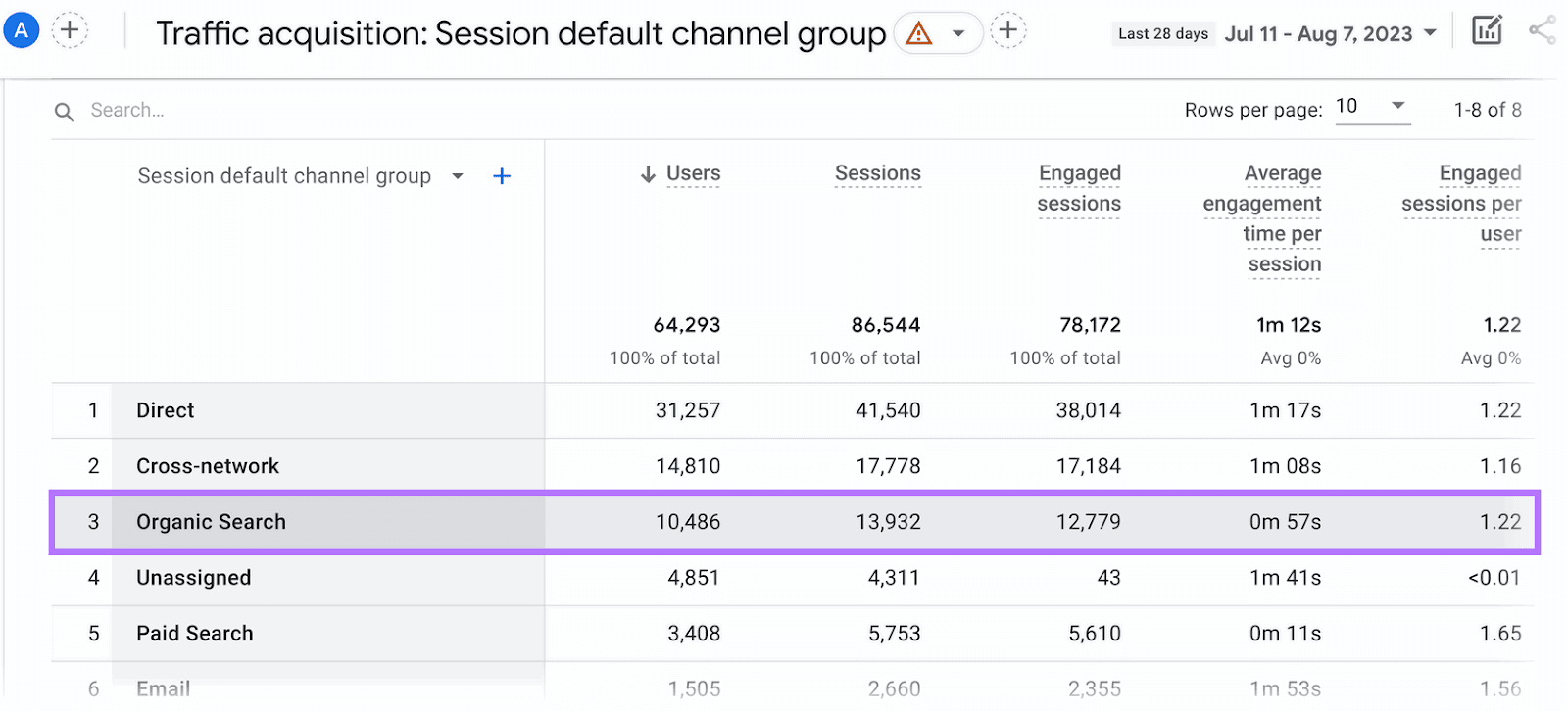
Start Applying These SEO Tips for Startups
The SEO industry can sound complicated. But avoid the noise and just start.
You’ll learn a lot as you go, and results will compound over time.
To speed up your startup SEO efforts, sign up for a free Semrush trial. So you can start using tools that simplify keyword research, competitive analysis, and more.
